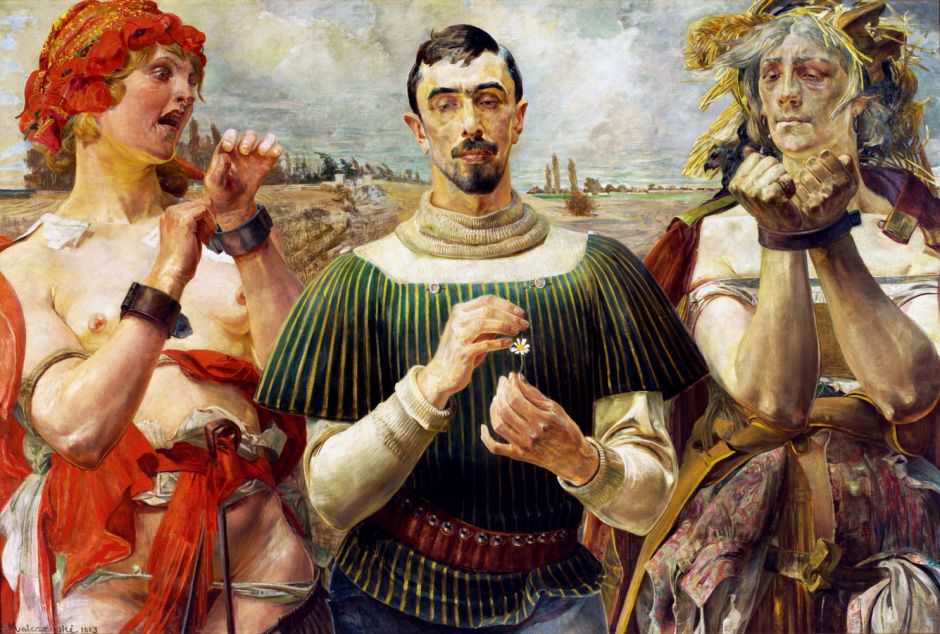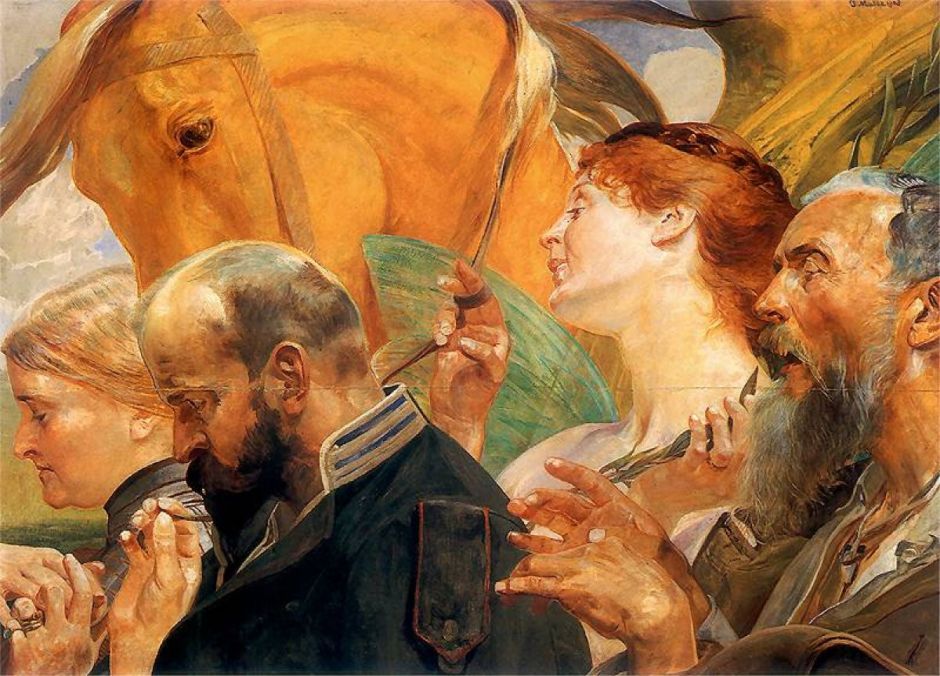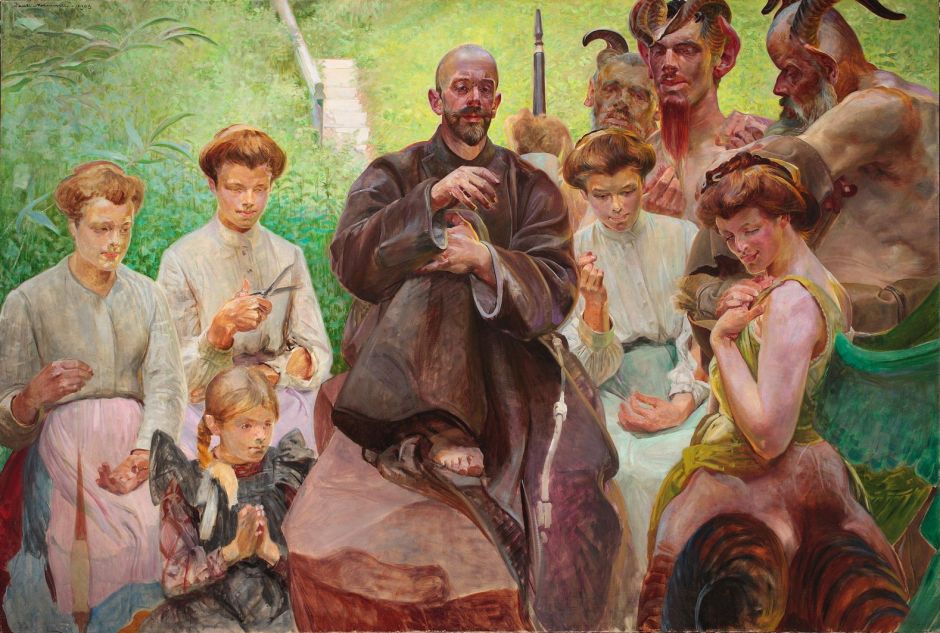In the first article of these two about the paintings of Jacek Malczewski (1854–1929), I looked at his depictions of Polish exiles in Siberia, narratives such as the story of Tobias, and recurrent themes including death and Medusa. By the early twentieth century, he was established as the leading painter in Poland, a nation which was steadily awakening and rapidly becoming more industrial.

Malczewski painted many portraits throughout his career. Rather than produce simple likenesses, he usually set his sitter in a very personal narrative which may now be difficult to read with the loss of its original context. A Lark. Portrait of the Painter Antoni Zembaczyński from 1902 is a good example, in showing an artist who was slightly younger than Malczewski, having been born in 1858, and dying in 1917. Instead of putting a brush in his hand, the subject is holding a violin and its bow, as a woman clutches a lark close to his face.

Polish Hamlet – Portrait of Aleksander Wielopolski (1903) is an incisive political commentary on the career of Aleksander Ignacy Jan-Kanty Wielopolski (1803-1877), who was head of Poland’s civil administration under the Russian Empire, from 1862 to 1863. An aristocrat and conservative, he was sent to London to try to obtain the assistance of the British government during the 1831 November Uprising in Poland. He then wrote a controversial letter responding to the Galician massacres in 1845, and tried to stop the growing Polish national movement in 1863. However, in forcing the conscription of young Polish men into the Russian Army, he provoked the January Uprising of 1863, which forced him to flee into exile in Dresden.
Wielopolski is shown here in the role of Shakespeare’s Hamlet, with Ophelia at the left, and Gertrude, Hamlet’s mother, at the right, the two women representing the Polish nation.
Malczewski painted at least two triptychs, of which I show Law, Country, Art from 1903.

For the panel representing Law, Malczewski ignores conventional symbolic language: framing a resolute man are a faun playing a wooden flute, and on the left a woman who might represent Justice.

Country is a portrait of the artist’s lover, Maria Bal or Balowa, together with two children, in the fields around a distant city. The girl at the right has a manacle in her hand, presumably referring to the bondage of the Polish nation.

Art is similarly cryptic, with four figures, one of them blind, apparently processing from right to left, beside a horse’s head. The woman towards the right has large butterfly wings, and the horse’s rein is looped around two of her fingers.

In his Artist and The Chimera (1906), Malczewski returns to his innovative re-interpretation of classical Greek mythology. His chimera is part woman, part eagle, its fearful claws scratching at the artist’s bare chest as he lies captive under it. Chimeras were a theme in several of his paintings, but were usually less predatory or threatening.

Death of Ellenai (1906-07) is the second painting which Malczewski made of this theme drawn from the 1837 prose poem Anhelli by the Romantic writer Juliusz Słowacki (1809-1849). Anhelli is a Polish youth, and Ellenai his companion in misery as they travel through the wastes of Siberia. A young man is kissing her feet, as her body lies on hay with dead game hanging at the right.

A couple of years later, Malczewski depicted others paying similar tribute in The Artist’s Death (1909). The figure on the left is presumably Thanatos, as she is holding a scythe with her left hand. This appears to be set in the artist’s studio.

In Saint Francis of Assisi (1908) Malczewski modernises the Fates (Parcae) in this fascinating allegorical portrait, starring the artist in its title role.
All three Fates appear similar, with similar clothing, hair, and features. Clotho is at the left, with a pink apron, Atropos holds a modern pair of scissors rather than the traditional shears, and has a light purple apron, and Lachesis is on the other side of St Francis, with a pale blue apron. The right of the painting contains a group of semi-human mythical creatures, rather than the traditional birds and small animals typically associated with this saint.

Eloe (1909) is a very complex pair of intertwined figures developed from his theme of winged angels. The female stood in the foreground appears to be winged, and there is a recumbent figure behind her, who seems to be resting on feathered wings which girdle the first angel. The symbolism here has perhaps become a little too obscure to be readily interpreted.

Christ and the Samaritan Woman (1911), which again casts Malczewski in the title role, is a simpler composition showing the New Testament story. The model used as the Samaritan woman looks to be Maria Bal or Balowa (née Brunicka) once again.

Malczewski’s Portrait of Brigadier Józef Piłsudski (1916) shows this hero and Chief of State, who was so important in the building of the Second Polish Republic after the First World War. Józef Klemens Piłsudski (1867-1935) was sent to Siberia in 1887 following a plot to assassinate Tsar Alexander III, imprisoned in Warsaw Citadel in 1900 for operating a socialist underground printing press in Łódź, and a leader in the building of Polish military forces in anticipation of the First World War.
Behind the image of Piłsudski are faint dancing wraiths in the form of skeletons.

His radical version of The Annunciation from 1923 shows Mary (right) as a modern young woman, whose thimble and scissors rest on a bare wooden table behind. Gabriel is in the midst of breaking the news to her, his hands held together as he speaks. The window and curtains make clear that this is twentieth century Poland, not the Holy Land two millenia ago.
Soon afer painting that, Malczewski’s sight failed, and he died in Kraków in 1929. He was buried in the city’s equivalent of the Panthéon, the crypt of Skałka, the Basilica of Saint Michael the Archangel and Saint Stanislaus the Bishop and Martyr.
References
Wikipedia.
Culture.pl – an excellent account in English.

